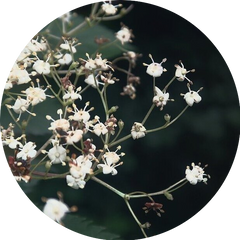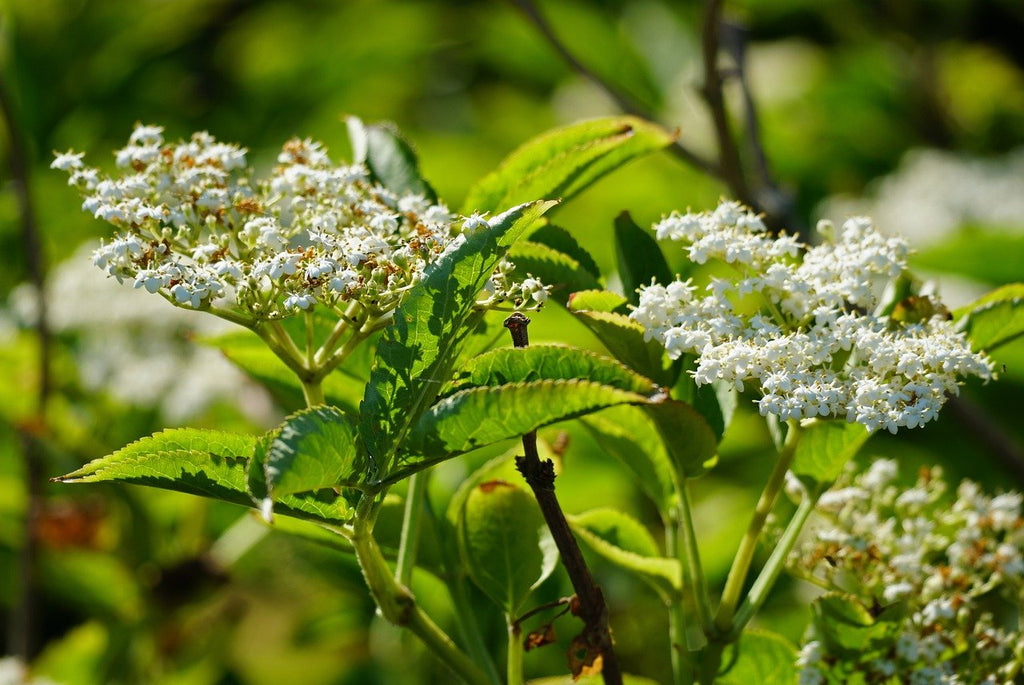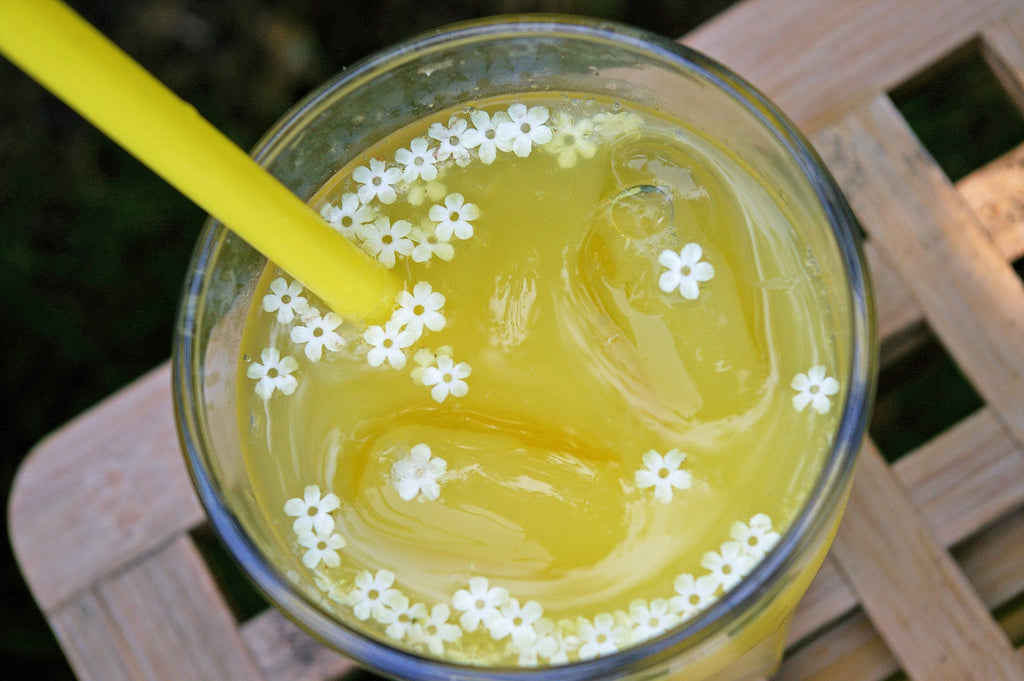by Rebecca Andrews, MA, MS

Each spring I watch as the elderberry bush behind my mailbox lifts its spindly branches free of the multiple feet of snow weighing it down. I watch as the leaves begin to bud. I watch, as finally, blossoms begin to emerge. And then it is time….
Gathering basket hanging over one arm, I use my other hand to gently tickle off the flowers, being careful not to break them off completely, leaving the ovaries behind to emerge into berries. Next, I take a drive around the dirt roads on my mountain. Armed with my gathering basket and outfitted head to toe in long loose clothing to defend against the biting black flies, I gather my medicine for the following spring. No matter how many blossoms I gather, it never feels like enough. I carefully ration out some for honey and the rest for my favorite spring allergy tincture.
If you’re using fresh blossoms, be sure you consult a good foraging resource and know poisonous look-alikes. You will want Sambucus nigra elderflowers only. Spread blossoms on a flat surface and leave them to wilt for 6 hours or more… long enough for insects to crawl out before you make use. There’s a sweet little green spider that especially loves to make its home in the floral sweetness (can you imagine such a sweet home?!) If you’re using dried blossoms, you’re all set to go.
When it comes to herbal goodness, we’re all more familiar with elderberries than with the blossoms, but the blossoms hold similar - and yet potently different support for us.

What does the science say?
According to Braun & Cohen in Herbs & Natural Supplements: An Evidence-Based Guide, “Elderflower preparations are traditionally believed to have expectorant, decongestant, and diaphoretic activity… Elderflower exhibits antiviral, anti-inflammatory, antioxidant, antibacterial, antiproliferative, diaphoretic, diruetic, and anti-diabetic properties.”
According to Hoffman, elderflowers are “diaphoretic, anticatarrhal, and antispasmodic.” He goes on to relate that “Elder flower is ideal for the treatment of colds and influenza… is indicated for any catarrhal inflammation of the upper respiratory tract, such as hay fever or sinusitis. Catarrhal deafness responds well to elder flower.”
With this mix of properties, my favorite way to use elder flowers - aside from simple joy in their delicious flavor - is if I’m experiencing spring allergies or a cold.
Safety
Braun & Cohen relate that elder is safe to use in pregnancy “in dietary amounts” but state that “safety is not known when used in larger quantities.” They also note that - as with anything - some folks can be allergic to elder flowers. Hoffman notes, “No side effects or drug interactions have been reported.”
Tincture
Dried herbs are generally tinctured at a 1:5 ratio - 1 part herb to 5 parts of alcohol. For example, use 1 ounce of herb to 5 ounces of alcohol. This formula will look very dry and you will need to push the herbal matter down into the alcohol or use a blender to really mix it. The folk method would be to put the herb in a jar and pour alcohol over it to cover. This method will be less potent, but yield a greater amount of tincture making it easy to take more more at once. In any case, leave your herbal particulate in the alcohol menstruum for a minimum of 6 weeks. Shake daily (or as often as you remember; kids often love this task.) I tend to leave the herbs right in my tinctures for a year or more, straining out small amounts of alcohol to put into a tincture bottle as needed. I’m sure at some point there’s nothing more that the alcohol can extract, but, to my knowledge, there are no studies revealing just how long the extraction period for each herb is. I figure I’m getting a maximum strength tincture this way.
Infusion
James Green, author of The Medicine Maker’s Handbook, (a great book by the way) recommends 1 part dry herb with 5 parts water - or an ounce of herb per pint of water. Obviously, for bulkier and lighter herbs, you might need more water. My method and “ratio” is to simply add what looks to me like a lot of herb to a pot of water, bring to just under a boil, turn off heat and cover for 30 minutes, gently reheat, strain and drink. There’s not really a right or wrong way. You can begin with some loose herb in a loose-herb-tea-ball, and have a milder mug of tea and then experiment with higher amounts of herbs, since this herb is considered quite safe.

Honey
Source a high quality, raw, organic honey from a local apiary that leaves enough honey for the bees to use too. Mix blossoms into honey. If it’s raw and crystallized, it’s ok to heat it very gently in a double boiler just enough to mix in the blossoms. Allow to infuse for 6 weeks. Try not to sneak tastes (this will be challenging!) You can gently heat the honey and strain out the blossoms, or simply leave them in for extra texture and flavor. This will have a delicious delicate floral sweetness. I recommend saving it for the deep, dark days of winter when you’re craving summer’s warmth. Then, mix with your favorite tea (chamomile is lovely) or spread on your favorite sourdough toast or other baked goodies. This has such an amazingly lovely floral sweetness to it! It’s delectable!
Skincare
Steam - Use a warm infusion for a facial steam. Pour into a bowl. Place freshly washed face over bowl and a towel over the face. (Be mindful of temperatures and not to spill hot liquids.)
Facial - Spritz the face with strained infusion after washing. Your infusion will store in the fridge for a few days.
Bath - Use dried elder blossoms (Sambucus nigra) in a reusable cloth bag or old clean sock. Tie closed. Place in the bath under running water.
Our elderflowers are organically sourced from Europe and carefully packaged in non-BPA packaging.
So there you have it… some of my favorite ways to enjoy elder blossoms. What are your favorite ways? Leave a comment below and let us know!
References
Braun, L. & Cohen, M. (2015). Herbs & Natural Supplements: An Evidence-Based Guide. 4th ed. Volume 2. Elsevier: NY.
Green, J. (2000). The Herbal Medicine-Maker’s Handbook: A Home Manual. Crossing Press: Berkeley, CA.
Hoffman, D. FNIMH, AHG. (2003). Medical Herbalism: The Science and Practice of Herbal Medicine. Healing Arts Press: Rochester, VT.

